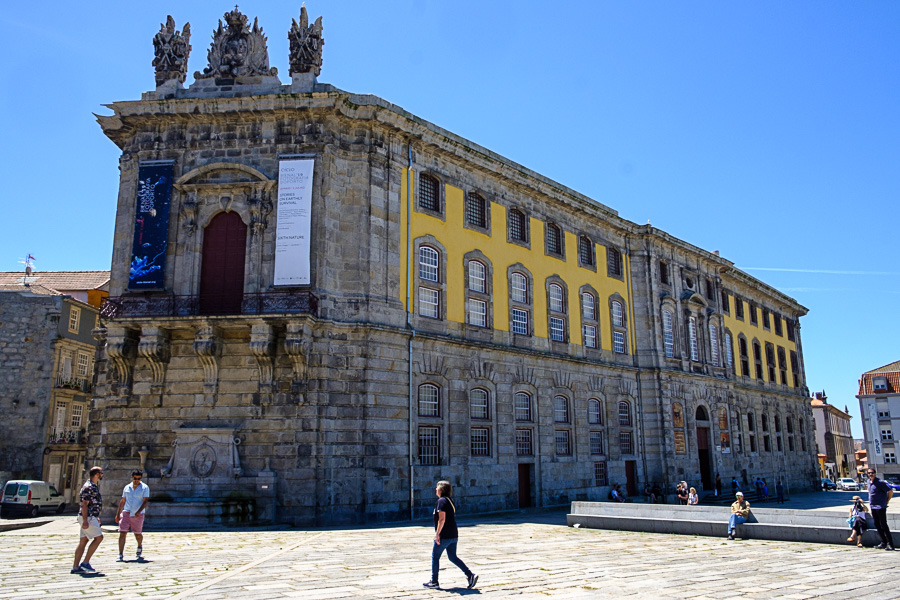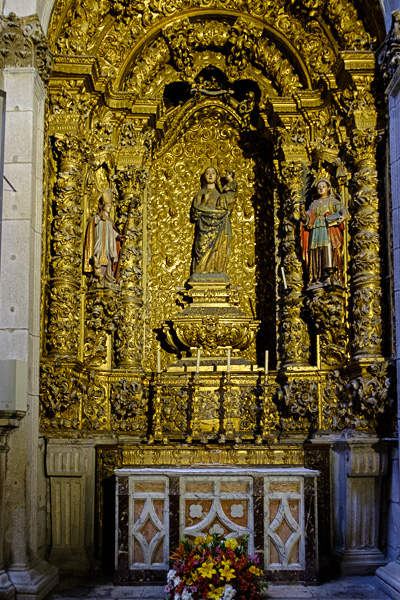At first, as we set out on our walking tour this morning, one day in Porto seemed awfully short. But now, at 5:30 PM, I think we’d need to spend not another day or two but rather a week to do it “right.” It’s a beautiful city, much more so than Lisbon, with much to do and much going on. The disadvantage of staying longer is that our bellies would expand day by day. As I think I said before, visiting Portugal is first and foremost about the eating. Experiencing the friendly people is second. Then comes seeing the sights. I suspect the high payback task is to learn to live like a Portuguese: to enjoy food and friends with a relaxed view of life and a good sense of humor. We’ve been in Portugal long enough to get a sense of that, so maybe it’s OK to move on.
Ours was a history walking tour (I picked it more or less at random of the Internet) and it was OK, but the historical information was hard to hear in the noisy street environment and, when audible, duplicated much of what we’ve already heard. Some of the details were new but the overall scope was similar: Celts, Romans, Visigoths, Moors, Spanish, Independence. Much of the emphasis here was on Dom Pedro IV under whose statue we met for the tour. You may recall that the same guy adorned the square outside our hotel in Lisbon, so it was kinda like coming home. Once again most of our group were youngsters and many from non-English speaking countries.
Recall that Dom Pedro IV was also King Pedro I of Brazil. He is viewed as the liberator of both Portugal and Brazil. King Jaoa I, Pedro I/IV’s father, had escaped to Brazil with his family when Napoleonic forces invaded Portugal in the early 1800s. Later, after the French were gone, the Absolutists (those favoring return to absolute rule by a king) and the Liberalists (who favored a more representative form of government) were fighting for control. Jaoa left for Portugal to straighten things out. He left his eldest son, Pedro, as King Pedro I of Brazil. Pedro quickly, under pressure, sided with Liberalists in Brazil and worked to liberate Brazil.
Meanwhile, Jaoa died and before he did, he named Pedro king of Portugal. Pedro didn’t want to leave Brazil (he had more than one Brazilian lady on the string) so in a stroke of genius he named his daughter, Maria, to be Queen Maria II. Because Maria was only 7 at the time, Pedro named his brother, Miguel, to be the queen’s regent. He also pledged his daughter’s hand in marriage to his brother (and her uncle), Miguel. And you thought you had family problems!
Miguel quickly reneged on the deal and, siding with the Absolutists, declared himself king. Pedro finally came back, fought with the liberal troops to regain control. He was successful – he liberated Portugal! – but died shortly after from tuberculosis. Queen Maria II took over, married the guy from Austria who built the castle in Sintra. Remember?
Our tour focused on this saga. Pedro’s army was besieged in Porto for a year during the war. Maria spent time here. One of the interesting stops was at the railway station where portions of Portuguese history are depicted in large blue-and-white tile murals. We walked by the main cathedral and by various vantage points around the old city.
After the tour our guide offered to take us to a restaurant where we could sample a traditional Portuguese favorite, Francesinha:
Francesinha is a Portuguese sandwich originally from Porto, made with bread, wet-cured ham, linguiça, fresh sausage like chipolata, steak or roast meat, and covered with melted cheese and a hot thick tomato and beer sauce. It is typically served with french fries. Wikipedia
Sort of like a Cuban sandwich, but with sauce over the top. We skipped the fries, but to stick to the traditional Portuguese theme (and to satiate Judy’s new-found craving for Port wine) we had a single, shared glass of semi-dry Port. And one can’t drink port without food, preferably dessert, so we were forced to share a chocolate mousse.
After we rolled down the hill to the main cathedral and toured it. But the real eye opener was the Church of St. Francis, which has its origins in the 13thcentury. Its exterior has been reworked several times and now is one of most outstanding examples of gothic architecture in Portugal.
But wait, there’s more. In the 17thcentury, flush with gold from Brazil, the church’s interior was redone in the largest collection of gold I’ve ever seen. And it was done in the then-current baroque style. Photos are not allowed in the gilted sanctuary even though picture taking is OK elsewhere. Maybe they’re embarrassed by the excess.
One piece that caught our eye was a wooden sculpture, the Tree of Jesse. Jesse is at the bottom. The twelve kings of Judah are entwined in the branches of the tree that grows from Jesse and Mary and the baby Jesus are at the top of the tree. Remember the line from the Bible and Handel’s Messiah? “And there shall come forth a rod out of the stem of Jesse, and a Branch shall grow out of his roots”
Then back home, just 100 meters from the St. Francis. But first we stopped to buy a bottle of Dalva port and a neckless for Judy.
Tonight we’re off by Uber to the Praia de Lux, a restaurant on the Atlantic coast recommended by Niece Amy. So far her advice has been impeccable. We’ll see how it goes tonight!
*** Three Hours Later ***
Trust Amy. It was an awesome spot right on the ocean, waves crashing, sunset, the whole nine yards. And the food? Gourmet+ Judy had black Iberian pork; I had the cataplana, which is the Portuguese term for a copper pot in which a combination of fish and shell fish is prepared, in a sauce, with potatoes. I already have a recipe to try at home. We needed dessert like a hole in the head but, hey, it’s our last night in Portugal and so we ordered Judy’s favorite semidry white Port, paired with a chocolate concoction that, on the menu, was described as “explosive.” I had to hire two strong men to carry me out to the curb to catch our Uber back to town. It was a $ or maybe $$ pricier than the $$ joints we’ve been frequenting but I’m sure if I can get the hours I can pay it off in a solid week greeting at Wal-Mart.
Tomorrow starts our four-in-four sequence: four cities in four nights. We’ll be living out of the trunk of our Sixt car. First stop: Santiago de Compostela, Spain. So long Portugal!













































